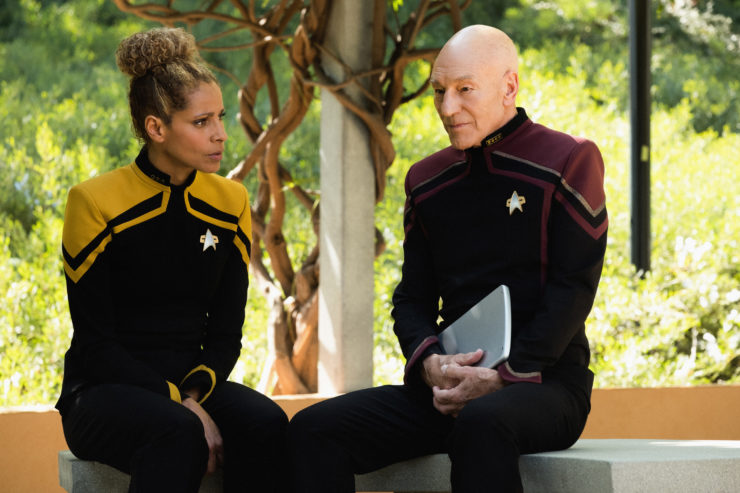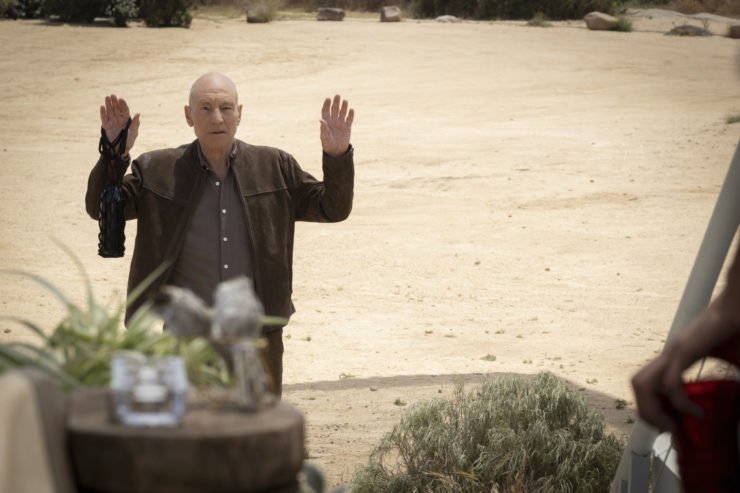When retired Admiral Jean-Luc Picard says “Engage!” in Star Trek: Picard, longtime fans of The Next Generation all high-fived each other, or possibly, their own childhoods. But did it take too long to get us here? With three episodes of Picard released so far (out of the total ten) there’s a contingent of criticism that laments how sluggish the series is moving. When you look at reviews for Picard, even the very positive ones seem to go out of their way to say the show is “slow.”
But, to that criticism, I have a question: Did we all forget that The Next Generation was perhaps the slowest Star Trek of them all? In fact, I’d argue, that loving Star Trek is—at least partially—less about saying “engage” and more about saying, “make it…slow.”
Light spoilers ahead for the first three episodes of Star Trek: Picard.
Okay, so Jean-Luc Picard does not leave the planet Earth for the first three episodes of Star Trek: Picard. For a hero of a Star Trek series, this is a little bit unprecedented; after all, it’s called “Star Trek,” which means, we demand that people be doing some trekking around the stars, right?
Well, not really. Famously, in The Next Generation, what defined Jean-Luc Picard—in contrast with Mr. Punch-It Captain Kirk—was his tendency to manage space chaos from the bridge of the Enterprise, rather than constantly beaming down to dangerous planets. In was Riker’s job to go down and do the alien planet-based dangerous stuff, and what made Picard a realistic leader is that he didn’t presume to do other people’s jobs for them. This gave the stories in TNG a greater weight than we had previously experienced in Star Trek, because if Picard had to come down there then you knew something was serious.
This tradition continues in the new series; we see Picard deferring to the expertise of other people to help him with his off-the-books quest. From Dr. Jurati to Rios and Raffi, and even his Romulan bodyguards/housekeepers, Jean-Luc still likes to approach all of this Star Trek-ing from a place of deliberation first, and action second.

And that means a lot of talking. This narrative feature was true of The Next Generation and it’s true of Picard, too. Some of the most famous episodes of The Next Generation—even the action packed-ones—have a lot more talking than action. “The Measure of a Man”, an episode that may have kicked off the entirety of Star Trek: Picard, is considered to be one of the finest episodes of TNG, and it mostly involves people sitting around in a crappy conference room on a Starbase, yelling about Data’s civil rights. Ditto for “The Inner Light,” in which Picard forgets his life as starship captain and just…talks with his family and village. Two TNG episodes which, any fan will tell you, are bonafide classics of TNG are actually constructed of narrative beats that are antithetical to “action” or “speed.” In other words, The Next Generation was decidedly NOT an action-adventure series, and it carries that pace into its follow-up show Star Trek: Picard. (Arguably, Star Trek: Discovery is closer to TOS than TNG in this exact way.)
Speaking to Wil Wheaton on the aftershow, The Ready Room, Akiva Goldsman—one of the producers and creators of Picard—pointed out that the basic difference between TV now and TV in the ’90s is that episodic series (like TNG) could embody various narrative genres week-to-week, which isn’t something that Picard can support. “For us, because we’re serialized, it’s like each season is an episode. Our tone, is sci-fi/drama. You know, Discovery is sci-fi/action-adventure.”
This is an important point to linger on since our most recent memories of Star Trek are relentless in their action, from the 2009 JJ Abrams film to the recent two seasons of Discovery. With that as our recent guide, we might be remembering the pacing and events of The Next Generation, as quicker than they actually were. For example, one of the most action-packed episodes of The Next Generation, “The Best of Both Worlds, Part 1” has basically only one “fight scene.” (The first part opens with a dramatic scene of devastation! Then it cuts to a meeting. Then it chills out at a poker game. One quick trip back to the devastation. Then another meeting. Then a trip to Ten-Forward. Then a quick detour to bother Wesley. Vice Admiral Hanson almost literally has to step in and tell them to get back to work.) In the very first episode of Picard, there are two fights, and by episode 3, we’ve seen several more. You could argue that this is a superficial point—action doesn’t necessarily have to do with pacing—but if you think there was more speed and action in TNG, it’s demonstrably untrue.
And again, to Goldsman’s point, serialized television isn’t like episodic TV of the past, and that means Picard has basically committed to telling a TNG-drama story, in a 1o-part-serialized format. In this way, you could think of the entire season of Picard like a 10-part version of an episode like “Brothers,” or “The Chase,” or maybe even the tragically underrated “Attached.” There’s a Star Trek-y sci-fi premise here, but the pacing will honor the more thoughtful and talkative nature of TNG.
Perhaps the most hilarious moment in Star Trek: Picard so far is in episode 3, “Maps and Legends,” when Raffi says to Picard, “I don’t remember you being such a chatterbox back in the day.”
Oh, but he was, Raffi. Yes, he was. And the Jean-Luc Picard who sits around and talks about issues of galactic importance, while sipping tea or having a glass of wine is the man we loved in TNG, and the same guy we love now.
Ryan Britt is a longtime contributor to Tor.com and the author of the book Luke Skywalker Can’t Read and Other Geeky Truths (Plume 2015.) His other writing and criticism have been published in Inverse, SyFy Wire, Vulture, Den of Geek!, the New York Times, and StarTrek.com. He is an editor at Fatherly. Ryan lives with his wife and daughter in Portland, Maine.










